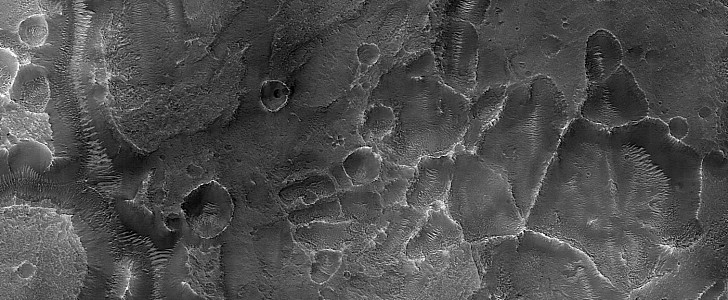If one were to peel away the layers of human-made objects, trees, water and ice off the face of our planet, we’d probably be left with a multitude of visible impact craters, testimony to the violent past of our solar system. For what it’s worth, Mars had it a hell of a lot worse.
It’s impossible to tell for sure how many impact craters there are on Mars. Luckily, we humans have that tool called estimate we keep on using when not enough data is available. And using that, we know these leftovers of rocks crashing into rocks are in the hundreds of thousands over there.
Scientists say there are about 385,000 craters larger than 1 kilometer (0.62 miles) over on Mars, and of them, 43,000 are larger than 5 kilometers (3 miles). To get a sense of things, consider there are just about 120 craters this large here on Earth.
Knowing those numbers and considering how Mars is about half the size of our planet, it’s easy to imagine that, at times, asteroids must have fallen in about the same places, creating areas that are now filled with craters.
It’s exactly such an area we’re looking at here through the lens of the HiRISE camera. Located in Arabia Terra, this patch of the alien planet, less than 5 km (3 miles) across, is riddled with craters, a cluster of them, as scientists say. We’re not told if these are primary or secondary craters (the ones formed after the ejecta of the initial impact on the surface), but the sight is frightening.
At the time of writing, Mars doesn’t seem to be as much in nature’s crosshairs as it used to be, despite its relative proximity to the Asteroid Belt, but areas such as this only go to show just how dangerous the place, considered by some for human colonization, is.
Scientists say there are about 385,000 craters larger than 1 kilometer (0.62 miles) over on Mars, and of them, 43,000 are larger than 5 kilometers (3 miles). To get a sense of things, consider there are just about 120 craters this large here on Earth.
Knowing those numbers and considering how Mars is about half the size of our planet, it’s easy to imagine that, at times, asteroids must have fallen in about the same places, creating areas that are now filled with craters.
It’s exactly such an area we’re looking at here through the lens of the HiRISE camera. Located in Arabia Terra, this patch of the alien planet, less than 5 km (3 miles) across, is riddled with craters, a cluster of them, as scientists say. We’re not told if these are primary or secondary craters (the ones formed after the ejecta of the initial impact on the surface), but the sight is frightening.
At the time of writing, Mars doesn’t seem to be as much in nature’s crosshairs as it used to be, despite its relative proximity to the Asteroid Belt, but areas such as this only go to show just how dangerous the place, considered by some for human colonization, is.






